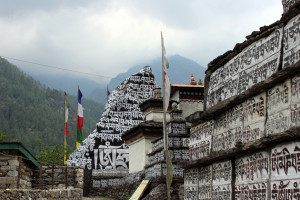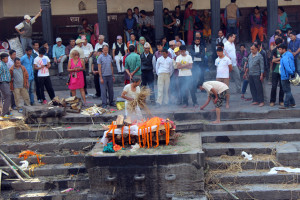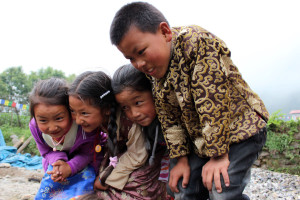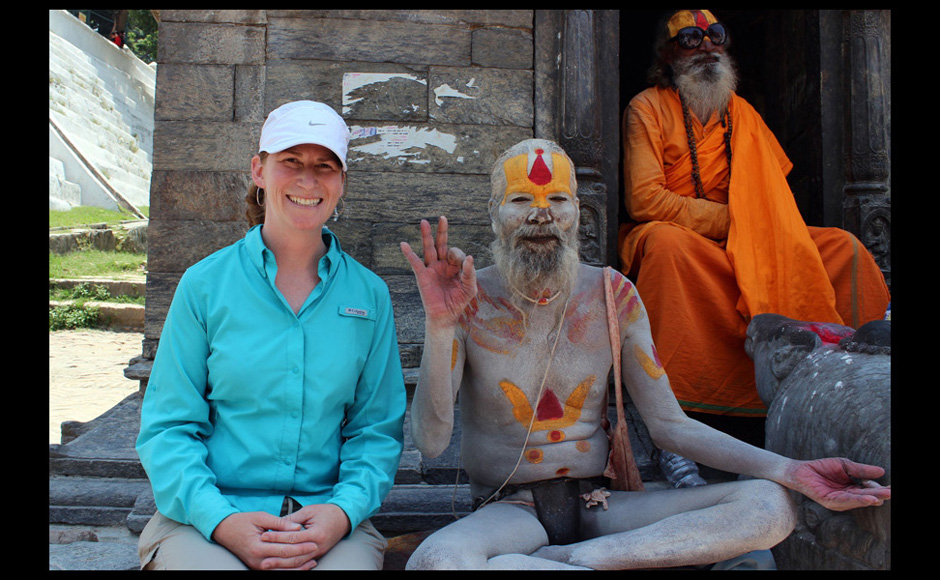Elizabeth Enck // Contributing writer
Photos by Elizabeth Enck
Smoke from incense and burning trash floats through beams of morning sunlight as shopkeepers say prayers to the gods, splash water on doorsteps in a morning ritual and metal gates up and down the street rattle as they are slammed open.
This is Katmandu, capital of the mountainous country of Nepal.
Nepal is one of the last forbidden kingdoms on earth, a place only recently broken from a god-king ruled monarchy. It is also the sacred birthplace of Buddha, and the only official Hindu state in the world.
Thousands of colorful shrines carved in trees, built in rocks, or snugly placed in walls line the narrow cobblestone streets where worshipers weave through heavy traffic to kneel by flickering candles, make offerings and throw bright red powder on their foreheads. This is called making “Tika.”

I chose Nepal for my study abroad because I am fascinated by the impact the two ancient world religions have on the people and surrounding culture.
Buddhists and Hindus worship in harmony side by side, sharing the same sacred temples, and even some of the same deities. Worshipers come from all over the world to make pilgrimage to the many ancient sacred sites I learned about in a comparative religions class.
For $5 I hired a rickshaw to take me across town. A skinny, sweating boy painstakingly dragged me and the rickety carriage up hills and through pothole ridden alleys, bike creaking, silk tassels swinging, and bell clanging.
The pollution in Katmandu is stifling, and work like that is hard. Morning brings the hacking and coughing of thousands desperate to clear their lungs. Cloth pollution masks can be bought on any corner.
We are headed to the UNESCO World Heritage site Pashupatinath, which is one of the most important Hindu Temples in the world. It is a temple to The Lord Shiva: God of destruction and rejuvenation. Hindus from all over the world make pilgrimage to this site.
It is also the cremation grounds for the Nepalese people.

When we arrive I can see the cremation platforms lining the sacred Bagmati River in descending order according to caste. It’s the dry season and the river is at a trickle.
Crowds of people gather to watch a person pass from this life into the next. Sacred cows, heads adorned in red powder, wander the grounds while packs of wild dogs scavenge for human bones. Children wade through the river, sifting for coins and jewelry sent with bodies into the next life.
This elaborately carved temple is also a place of sacrifice. Goats and water buffalo are regularly offered to the gods. At one time humans were also sacrificed, but the last human sacrifice was in the 1300’s. Hindu families were eager to please the gods by sacrificing their strongest male child in exchange for good fortune.
Hindus believe in balance. Pashupatinath (pronounced pash-u-pot-in-ath) is not only about death, it represents the full cycle of life. The other side of the river is lined with fertility pagodas, each housing a linga, or phallic symbol of Shiva. Most young families come here to pray for fertility.
The famed Hindu Holy men called “Sadhus,” skin covered in ash with handprints of bright red pigment, some wearing only a coconut shell, others brightly covered robes, sit outside the pagodas. They are smoking the marijuana that grows in the streets. Smiles are wide and they are pleased to bestow blessings on any who wish them.
The sights and sounds in Katmandu are amazing and relentless. But after a week and a half my lungs beg for mercy, so I head to my assignment high in the Himalayas near Mt. Everest and the Tibetan Plateau.
Nepal is a long narrow country bordered by China to the north and India to the south. The Newars are the indigenous people who have inhabited the area since pre-historic times. But, the country was born when 450 kingdoms of varying ethnicities, mostly Mongoloid (Mongolia) and Kas (Kashmir), were united in 1769.
A tiny plane skips like a rock on the currents of massive clouds, shaking its way through giant stone peaks where it will land, hopefully, on a miniscule runway balanced on the edge of a Himalayan mountain.
This is the only entrance to Mt. Everest, or the ‘Khumbu’ region of Nepal. All who dare to face the highest mountain on earth must also face one of the most dangerous airports in the world.

Every year Mt. Everest draws thousands of adventurers, mountaineers, volunteers, pilgrims and tourists from all over the globe. Reasons for visiting differ greatly, but all are driven by an intrigue in this mysterious, treacherous, and sacred region called “The Roof of the World”.
I am here to teach English to monks in an ancient monastery, in exchange for a chance to study Buddhism first hand.
It’s an independent study abroad program I designed with the help of the Religious Studies Department head Dr. Jenna Gray-Hildenbrand, and the study abroad office. I obtained financial support through the Benjamin A. Gilman Scholarship Program. The process was time-consuming, but well worth the effort.
Amidst the clouds at 9,380 feet, and wrapped in a heavy mist, Lukla is stunning. As we step off the plane still trembling, the thin crisp air awakens our senses. Once on solid ground, the sheer vastness of the place hits you. The sky is full of massive mountains that dwarf everything, stoic and looming in the fog. Nestled in the crevices of these giants are cozy little Sherpa towns reminiscent of times gone by.
They say the gods live here in the rolling fog of the mountains.
To get to my lodgings I make the four-hour trek over jagged stones slick with dew from mountain fog. From there I will hike five hours a day, to get to and from the monastery.
Despite treacherous terrain and leaps in elevation, I’ve reached the monastery through the pouring rain. Steam rises off my milk tea and I huddle by the wood fire in the kitchen, surrounded by young monks in maroon robes and sandals.
These are my students and my teachers. They are curious and kind, each one eager for the honor of pouring my tea. The cook has gone for the day, and a 10-year-old monk named Tashi busily prepares the food. Several small monks crowd around a giant iron pot, stirring potatoes as the strong scent of spices wafts through the kitchen.

This small monastery atop a giant mountain is over 900 years old, and is very important within the Sherpa community.
Originally from Tibet, the Sherpa people migrated to this region of Nepal over 500 years ago. Sherpas are the famous high altitude porters who guide mountaineers to the top of Mt. Everest. They are capable of carrying huge, heavy loads on their backs, supported by a single strap which rests on the top of their head. It’s not uncommon to see one man collect a refrigerator or iron stove that’s been flown into Lukla, and carry it on his back, into the mountain towns that are several days away.
The monks are busy preparing for Dumji, the biggest festival of the year. In preparation, Puja, or prayer, is being held all day long and I have been invited to attend this worship which is normally exclusive.
What an incredible experience to sit among these Holy Beings in their best form, chanting mantras that have existed for thousands of years. Every hit of the gong and drums shakes the thin air to vibration, and the rays of sunlight seem to beam brighter as they make their way through the old dusty windows, the lingering smoke of incense, and the steam of the ever-present milk tea. Even an outsider stifled by ignorance could feel the sacred abundance of life and ritual here.
This is why I traveled half-way across the world.










TLHMTSU15 • Nov 20, 2015 at 11:51 pm
Nepal is such a beautiful country. Even though I have never been there, reading this story recounting the experience makes me want to go even more. Having the distinction of being the only official Hindu state in the world is another reason why it sounds so enticing, as the Hindu religion has always interested me. Discovering another culture that is completely different from your own is something that I have experienced a few times in my life, yet I am always willing and yearning to learn more (especially if it’s by visiting a country as stunning as Nepal).
Being able to teach the monks of Nepal the English language must have been thrilling for the author. From what I’ve read, they seem like very enlightened and intelligent people, willing to embrace new ideas while keeping up with their own traditions. Learning about Buddha from the monks also sounds like it was a very exciting achievement for the author. A first-hand learning experience straight from the mouths of Buddhist monks sounds awesome. Reading about how beautiful the entrance to Mt. Everest is was another aspect of the article that I liked. It is indeed a dangerous to take such a risk climbing the deadly mountain, but I also understand the appeal.